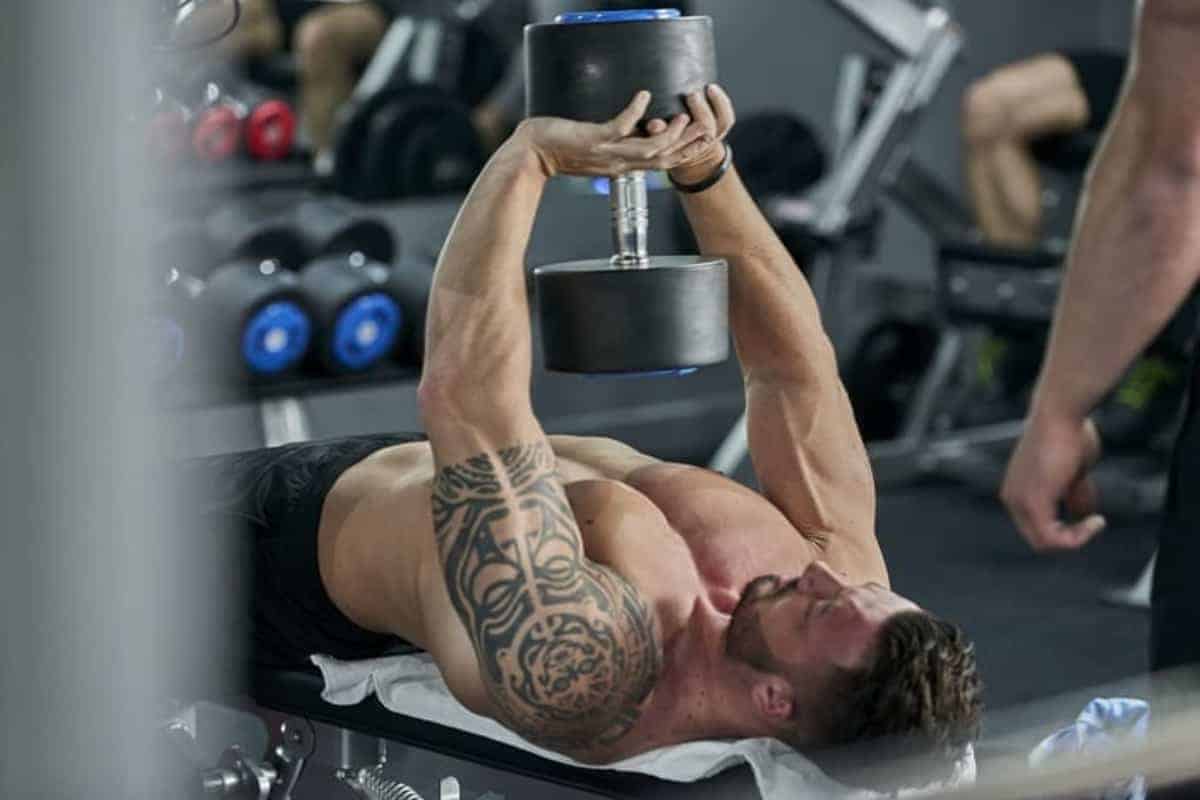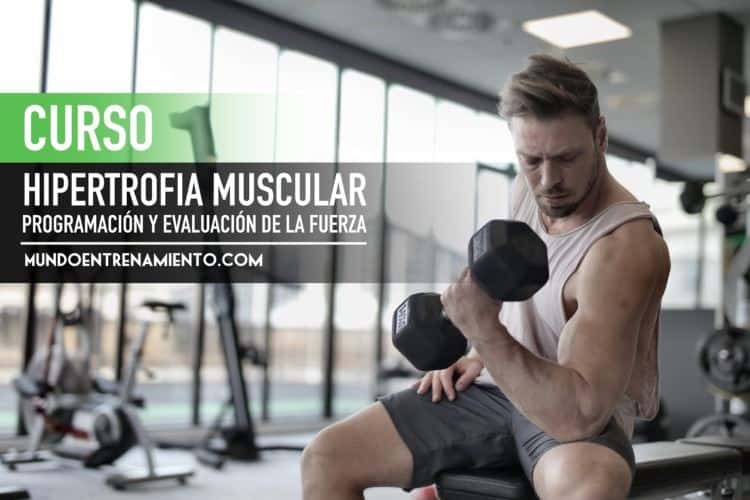The objective of this article is the analysis of one of the trendy exercises, the pull over. It is an exercise that raises many questions about whether it is for working the pectoral or the latissimus dorsi, something we will resolve in the following points.
What is the pull over?
The pull over is an exercise where the main action is shoulder extension.
The objective of this exercise is to isolate the shoulder extension to emphasize the stimulus on the muscles that perform this action, such as the pectoralis major, the triceps brachii or the latissimus dorsi.
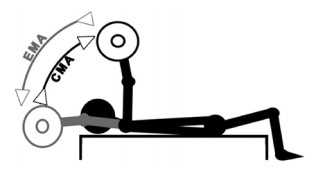
However, it should be noted that there are different variants of the Pull over and depending on which one we use, we will be working more on one muscle group or another.
How is the pull over exercise done?
In this article, in addition to analyzing the muscle activation of the pull over in all its variants, we will see in detail the execution of the pull over exercise.
Next, we will show you in detail how the pull over exercise is done:
Standing high pulley pull over
Another variant of this exercise, in this case, uses a pulley at the top and is performed standing. As we see in the image, in this case, the resistance vector is vertical.
What muscles does the standing high pulley pull over work?
In the standing high pulley pull over, it is the variant where the latissimus dorsi is most activated, especially from 90º of shoulder flexion until reaching 0º.
Other muscles that are highly activated are the triceps brachii, the posterior deltoid, and the serratus anterior, which acts by controlling and fixing the scapula to the rib cage.
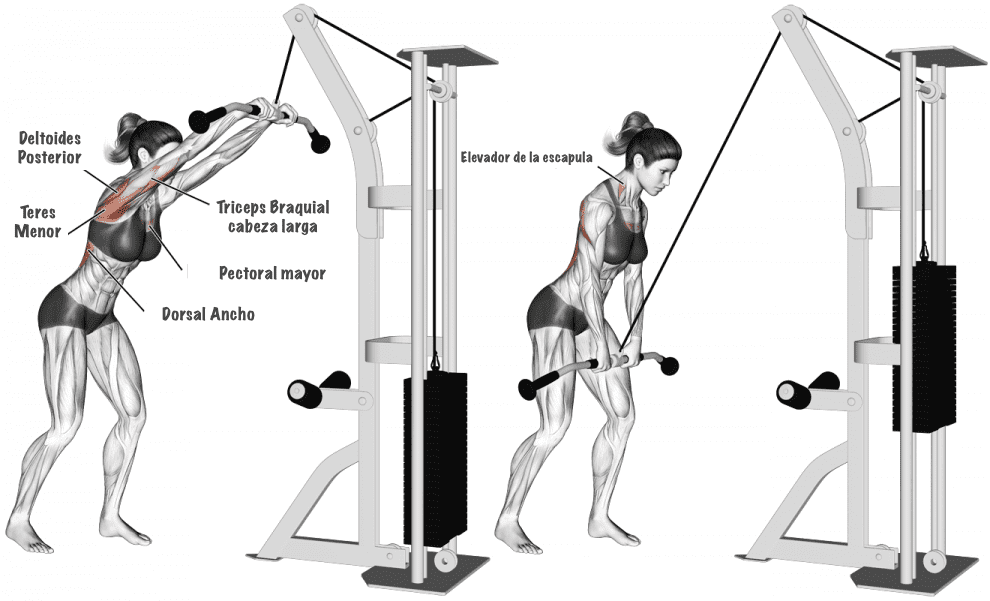
Starting position
The exercise starts standing with feet shoulder-width apart. Additionally, we should maintain a slight hip flexion and knees slightly bent.
Exercise execution
- From here, we must grab the bar attached to the high pulley and perform a shoulder extension with elbows slightly bent.
- The concentric phase of the exercise ends when the shoulder flexion is practically 0º. We can use as a reference when the pulley bar touches our thighs.
- Finally, in the eccentric phase, we will control the ascent of the pulley until reaching the starting position to perform the concentric phase of the exercise again.
Dumbbell pull over
In the dumbbell pull over, the resistance vector is anteroposterior.
Starting position
- The head, back, and glutes are in contact with the bench (in supine position) and the feet touch the ground.
- The movement starts by holding the dumbbell above the chest, with a shoulder flexion of 90º.
Execution phase
- The performer must perform a shoulder flexion until reaching practically 180º, so the dumbbell is behind the head (eccentric phase).
- Depending on the functional characteristics of the performer, the shoulder can be flexed more or less, but as a guide, the arms should be parallel to the ground at the end of the movement.
- During the descent of the dumbbell, we can keep the elbows slightly bent.
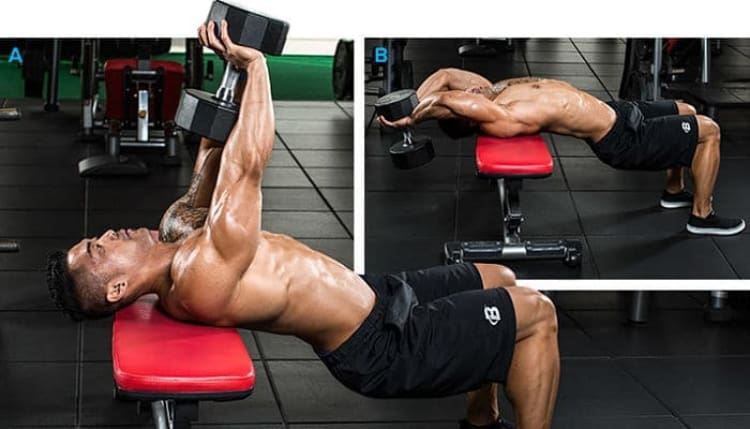
Once the dumbbell is behind the head, there is again an ascent phase until reaching the starting position:
- In the ascent phase (concentric phase), the performer performs a shoulder extension movement until the dumbbell is right above our chest. Therefore, we will stop when we find ourselves with shoulders flexed at 90º.
Barbell pull over
In the barbell pull over, the resistance vector is anteroposterior.
Starting position of the barbell pull over
- The head, back, and glutes are in contact with the bench (in supine position) and the feet touch the ground.
- The movement starts by holding the bar above the chest, with a shoulder flexion of 90º and elbows slightly bent.
- The arms are kept at a separation of the biacromial width (shoulder height).
Execution phase of the barbell pull over
Again, as in the dumbbell pull over, the movement of the bar should first be descending (eccentric phase) until it is behind the head.
Once this point is reached, the ascent phase of the bar begins (concentric phase) until it is right above our chest, with a shoulder flexion of 90º.

Muscle activation in the barbell pull over
In the study by Marchetti and Uchida (2011), they found that in the barbell pull over, the pectoralis major shows greater activation compared to the latissimus dorsi throughout the entire range.
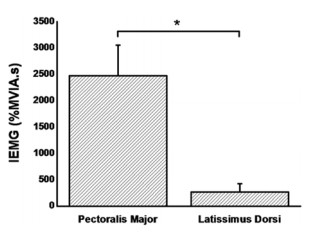
It is noteworthy that the activation of the latissimus dorsi corresponds to only 10% compared to that of the pectoralis major in the barbell pull over (3).
During the execution of the barbell pull over, there are significant differences in relation to muscle activation in the concentric and eccentric phases.
In the concentric phase, those who showed a higher percentage of activation were the pectoralis major (50.8%), the triceps brachii (34.3%), and the latissimus dorsi (22.7%) (3).
In the eccentric phase, the pectoralis major showed an activation of 27.5%, the triceps brachii of 20.5%, and the latissimus dorsi of 8.4% (3).
En este curso vamos a tratar el entrenamiento de la fuerza orientada a la hipertrofia muscular, buscando las formas de optimizar el proceso a la hora de planificar las cargas y las sesiones de entrenamiento.
Aprenderemos a determinar cuándo nos interesa conseguir esa hipertrofia, cómo esta afecta a los niveles de fuerza y la importancia de conocer el estado inicial de la persona que se someta a este tipo de entrenamiento.
What are the differences between the dumbbell pull over and the barbell pull over?
Next, we see a comparison of muscle activation between the barbell pull over and the dumbbell pull over.

In the following graph, we can see the differences in muscle activation between the barbell pull over and the dumbbell pull over.
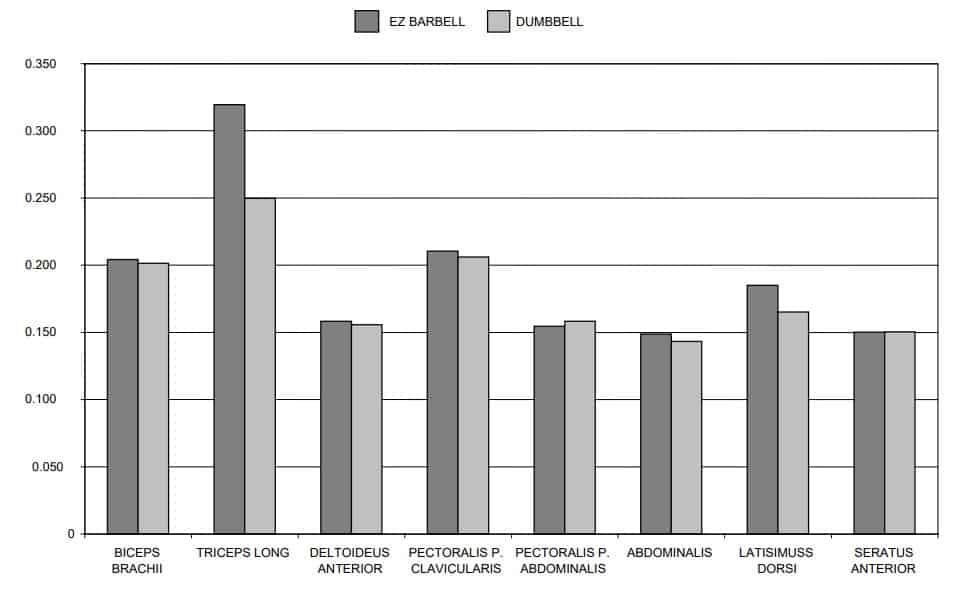
What is worked with the dumbbell pull over?
As we can see in both the table and the previous graph, the muscle activation of the barbell and dumbbell pull over is very similar.
The dumbbell pull over mainly develops the thickness of the pectoralis major and also engages the latissimus dorsi, anterior deltoid, long head of the triceps, serratus anterior, biceps, and isometrically the abdominal area.
There are only differences regarding the activation of the triceps, which has more prominence in the execution of the barbell pull over (4).
Variants of the barbell pull over
Pezarat-Correia et al. (2020) conducted a study in which they observed muscle activation through electromyography (EMG) in the barbell pull over in different variants:
1st variant: perform the exercise with the back and glutes supported on a step and with a grip at 100% of the biacromial width (shoulder width).

In the following graph, we can observe the levels of muscle activation in this variant.

2nd variant: perform the exercise with the back and glutes supported on a step and with a grip at 150% of the biacromial width (a little more than shoulder width).

Next, we can see the levels of muscle activation in this variant.

3rd variant: execute the exercise supporting the back on a fitball and with less load on the bar.

It is also noteworthy the percentages of muscle activation in the barbell pull over on an unstable surface and with less load on the bar.

Analysis of muscle activation in the three proposed variants
After the study, the authors observed that in the three exercises, there were high percentages of activation in the posterior deltoid (49-51%) and the latissimus dorsi (44-46%) (5).
The triceps brachii also showed a high percentage of activation (46-47%), likely because it is also involved in shoulder extension.
The fact of maintaining a slight elbow flexion during the execution of the exercise also conditions the percentage of activation of the triceps brachii (5).
The clavicular and sternocostal portion of the pectoralis major also had high percentages of activation (46-49% and 43-47% respectively). This is because they are major players at the moment of initiating the shoulder extension from 180º to 90º (5).
It is noteworthy that the muscle that presented the highest percentage of activation was the infraspinatus (51-53%). The infraspinatus is a dynamic stabilizer of the glenohumeral joint and also participates in shoulder extension.
When the pull over is performed with moderate-high loads, the infraspinatus becomes very important in the role of stabilizing the shoulder joint, especially when the arms are above the head (5).
Therefore, working the infraspinatus will be of vital importance for athletes whose sports actions require raising the arms above the head (e.g., water polo throws, javelin, or handball).
The serratus anterior showed an activation percentage of 36-39%, mainly involved in stabilizing the scapulothoracic joint.
It also acts as a synergist in allowing a correct scapular rhythm so that the scapulohumeral muscles maintain an optimal length-tension ratio during arm elevation movements (5).
The external oblique and transverse abdominis showed greater activation than the rectus abdominis (45-47% vs 35-42%).
This is because this musculature has the function of maintaining the hip and spine in a stable position during the movement. (5).
What conclusions can be extrapolated from the study?
Comparing the 3 exercises, there were no significant differences in relation to muscle activation of the muscles acting in the shoulder complex (5).
It was also seen that the grip width does not influence muscle activation in the 3 variants of the barbell pull over (5).
The only difference between the barbell pull over on a stable surface and on the fitball was in the activation of the rectus abdominis.
In fact, there was greater activation on the stable surface (35%) than on the unstable surface (39%).
This difference suggests that while the exercise is performed on the fitball, the action of the trunk extensors is enhanced to maintain posture, thus reducing the activation of the antagonists of this function, such as the rectus abdominis (5).
Behm et al. (2005) observed that there is only greater activation of the trunk stabilizing muscles (core) when the exercise executed on the fitball is unilateral.
Performing the exercise on a stable surface will allow us to move more load (5).
However, as we have seen in the graphs, muscle activation is very similar on both stable and unstable surfaces, so similar muscle activation patterns can be achieved with low loads on an unstable surface and with high loads on a stable surface.
Conclusions
In the dumbbell and barbell pull over lying down, the muscles that are most activated are the pectoralis major, the triceps brachii, and the latissimus dorsi.
If we want to focus the exercise on the latissimus dorsi, we will opt for the standing high pulley pull over.
If we want to emphasize the pectoralis major and the triceps brachii, we will perform the barbell or dumbbell pull over lying down.
The pull over is a great option to work the infraspinatus, which is a dynamic stabilizer of the glenohumeral joint.
This is applicable to those sports that present actions where the arms act above the head, such as in handball or water polo throws.
There are no significant differences in relation to muscle activation when performing the barbell pull over on a stable surface (bench) or unstable (fitball).
Podcast “Pull over: analysis of muscle activation of all its variants”: Play in new window |
Subscribe to Apple Podcasts | Spotify | Google Podcasts |
Course on Muscle Hypertrophy
If you want to learn more about the Barbell Row and how to get the most out of your workouts. We recommend our Course on Muscle Hypertrophy, based on the latest scientific studies.
Bibliographic references
- Behm D. et al. (2005). Trunk muscle electromyographic activity with unstable and unilateral exercises. J Strength Cond Res 2005; 19(1):193-201
- Graham, J. (2004). Dumbbell power. National Strength and Conditioning Association, 26(2): 48-49.
- Marchetti PH, Uchida MC. (2011). Effects of the pullover exercise on the pectoralis major and latissimus dorsi muscles as evaluated by EMG. J Appl Biomech, 27(4):380-4. doi: 10.1123/jab.27.4.380. Epub 2011 Oct 4. PMID: 21975179.
- Mejovsek, M., Kasovic, M., Harasin, D. and Pekas D. (2005). Effects of variations of the pullover exercise on the EMG activity of eight muscles. Conference on Kinesiology – Science and Profession – Challenge for the Future : Proceedings book, 402-405.
- P. Pezarat-Correia et al. (2020). Comparison of shoulder and trunk muscle activation between different pullover exercises. Revista Andaluza de Medicina del Deporte, 13(3): 127-133.
